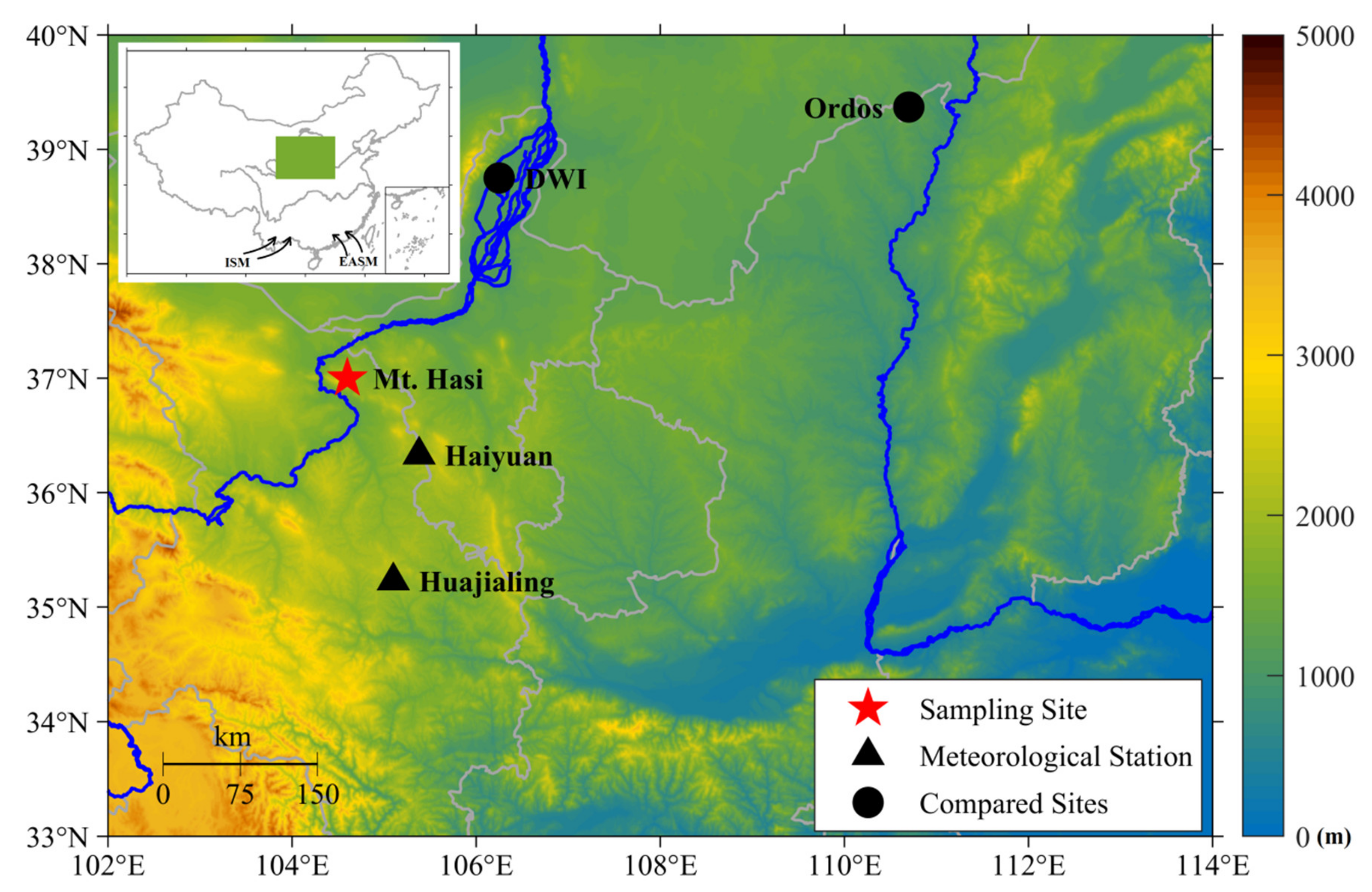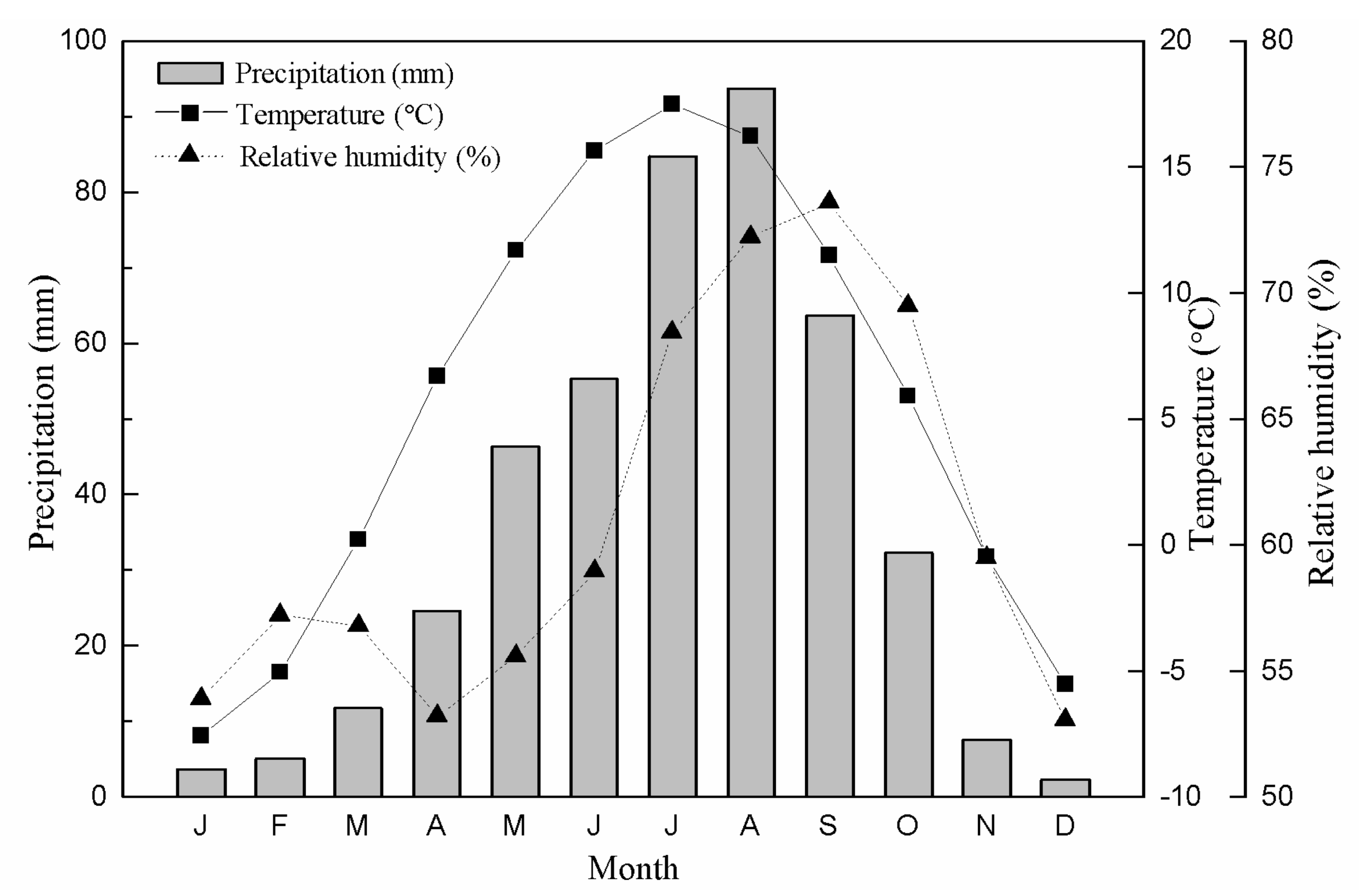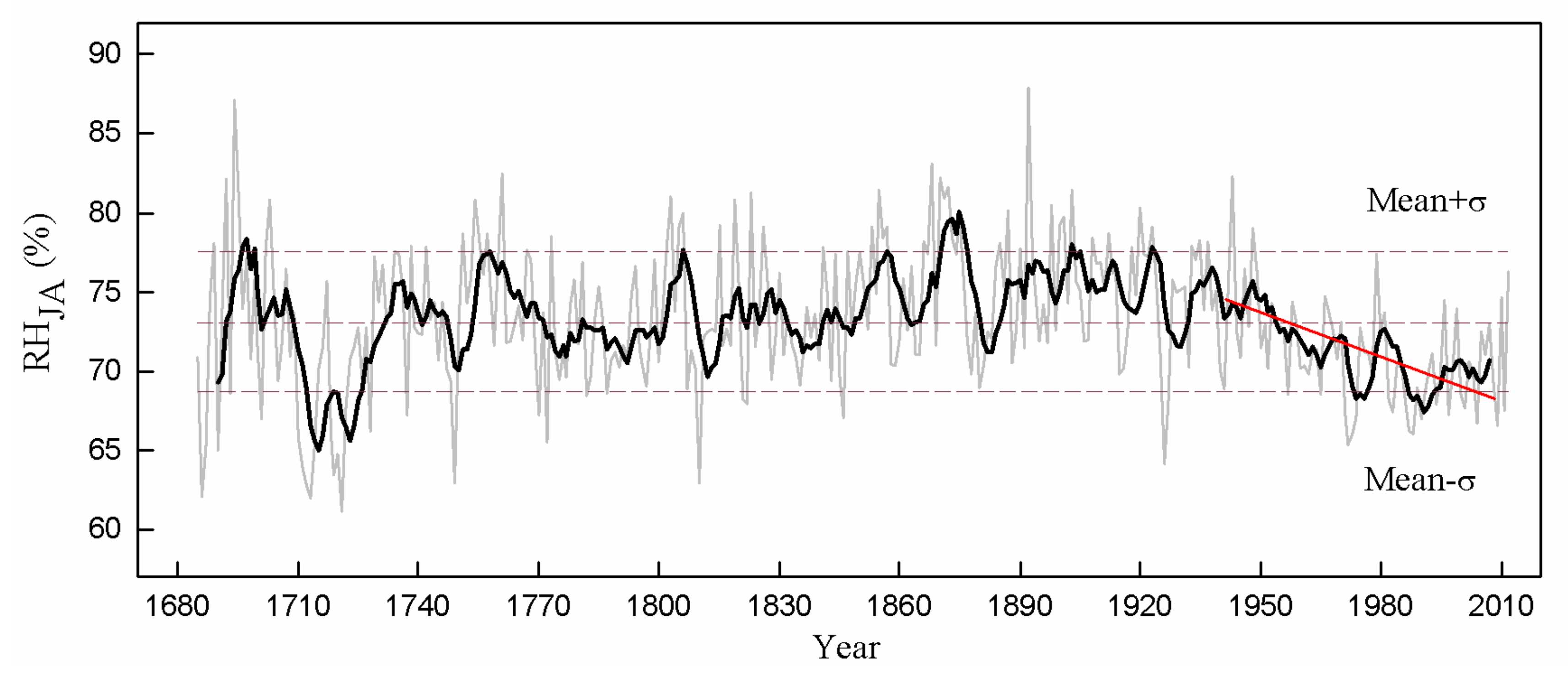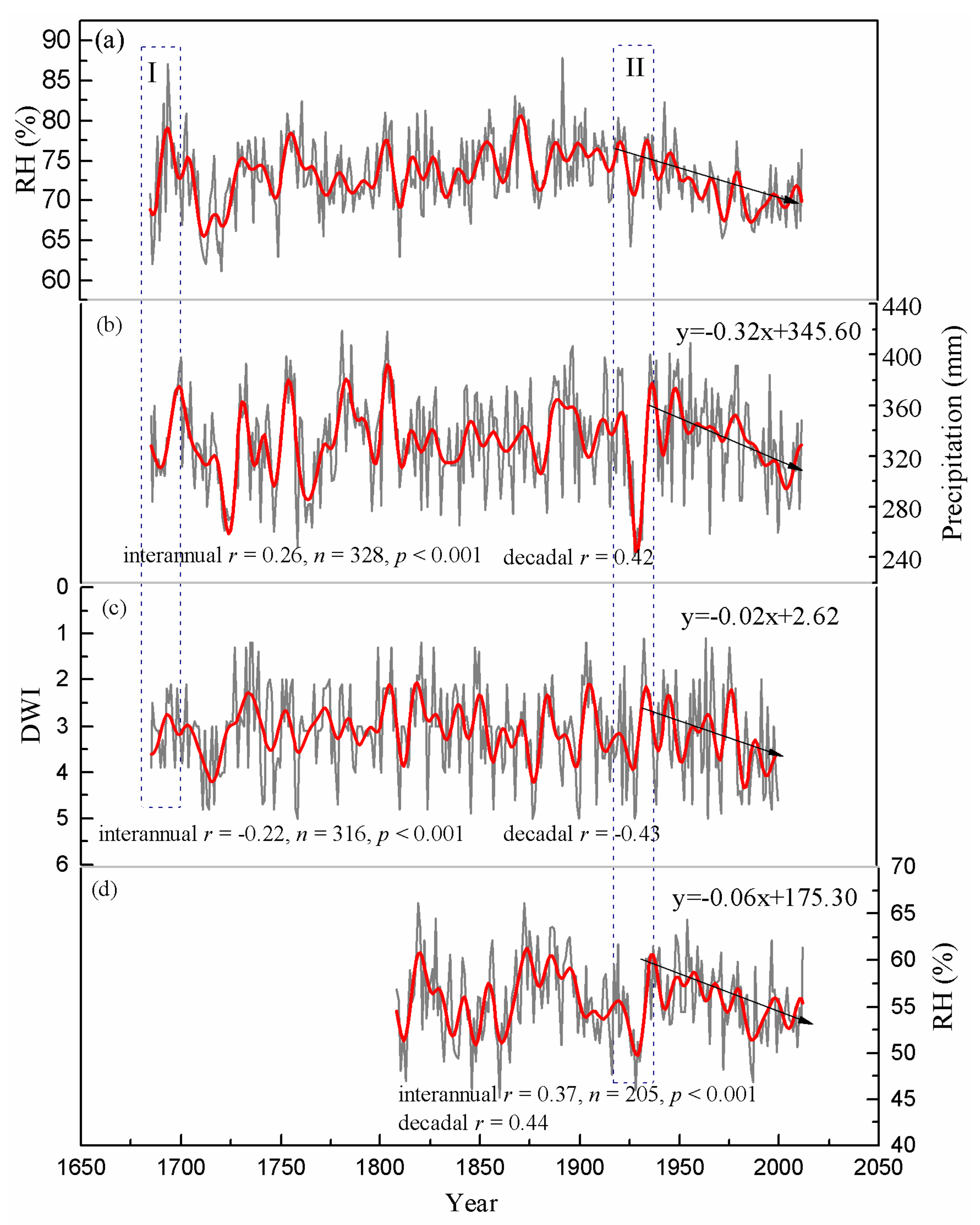An Asian Summer Monsoon-Related Relative Humidity Record from Tree-Ring δ18O in Gansu Province, North China
Abstract
1. Introduction
2. Materials and Methods
2.1. Study Area Situation
2.2. Tree-Ring Stable Oxygen Isotopes Experimental Method
2.3. Meteorological Data
2.4. Statistical Methods
3. Results
3.1. The Chronology of Tree-Ring δ18O
3.2. Climate Response
3.3. Reconstruction of RHJA during 1685–2012 CE on Mt. Hasi
(n = 55, r = −0.65, R2 = 0.42, R2adj = 0.41, F = 38.81, p < 0.0001, D/W = 2.21)
3.4. Periodicities of the RHJA Reconstruction
4. Discussion
4.1. Connection between Tree-Ring δ18O and Precipitation δ18O
4.2. Variation Features of RH Reconstruction in the Mt. Hasi Region and Its Relationship with ASM
4.3. Exploration of the Juvenile Effect
4.4. Possible Factors Affecting RH Changes in the Mt. Hasi Region
5. Conclusions
Author Contributions
Funding
Conflicts of Interest
References
- Wu, R.G.; Wang, B. A contrast of the East Asian Summer Monsoon-ENSO relationship between 1962–77 and 1978–93. J. Clim. 2002, 15, 3266–3279. [Google Scholar] [CrossRef]
- Ding, Q.H.; Wang, B. Intraseasonal teleconnection between the summer Eurasian Wave Train and the Indian Monsoon. J. Clim. 2007, 20, 3751–3767. [Google Scholar] [CrossRef]
- Zhou, M.; Tian, F.; Lall, U.; Hu, H. Insight from a joint analysis of Indian and Chinese monsoon rainfall data. Hydrol. Earth Syst. Sci. 2011, 15, 2709–2715. [Google Scholar] [CrossRef]
- An, Z.S. The history and variability of the East Asian paleomonsoon climate. Quat. Sci. Rev. 2000, 19, 171–187. [Google Scholar] [CrossRef]
- Li, H.M.; Dai, A.G.; Zhou, T.J.; Lu, J. Responses of east Asian summer monsoon to historical SST and atmospheric forcing during 1950–2000. Clim. Dyn. 2010, 34, 501–514. [Google Scholar] [CrossRef]
- Zhao, P.; Zhou, Z.J.; Liu, J.P. Variability of Tibetan spring snow and its associations with the hemispheric extratropical circulation and East Asian summer monsoon rainfall: An observational investigation. J. Clim. 2007, 20, 3942–3955. [Google Scholar] [CrossRef]
- Liu, Y.; Wang, L.; Li, Q.; Cai, Q.F.; Song, H.M.; Sun, C.F.; Liu, R.S.; Mei, R.C. Asian summer monsoon-related relative humidity recorded by tree ring δ18O during last 205 years. J. Geophys. Res. Atmos. 2019, 124, 9824–9838. [Google Scholar] [CrossRef]
- Shao, X.M.; Xu, Y.; Yin, Z.Y.; Liang, E.Y.; Zhu, H.; Wang, S. Climatic implications of a 3585-year tree-ring width chronology from the northeastern Qinghai-Tibetan Plateau. Quat. Sci. Rev. 2010, 29, 2111–2122. [Google Scholar] [CrossRef]
- Liu, Y.; Wang, C.Y.; Hao, W.J.; Song, H.M.; Cai, Q.F.; Tian, H.; Sun, B.; Linderholm, H.W. Tree-ring-based annual precipitation reconstruction in Kalaqin, Inner Mongolia for the last 238 years. Chin. Sci. Bull. 2011, 56, 2995–3002. [Google Scholar] [CrossRef]
- Mann, M.E.; Fuentes, J.D.; Rutherford, S. Underestimation of volcanic cooling in tree-ring-based reconstructions of hemispheric temperatures. Nat. Geosci. 2012, 5, 202–205. [Google Scholar] [CrossRef]
- Cook, E.R.; Krusic, P.J.; Anchukaitis, K.J.; Buckley, B.M.; Nakatsuka, T.; Sano, M. Tree-ring reconstructed summer temperature anomalies for temperate East Asia since 800 CE. Clim. Dyn. 2013, 41, 2957–2972. [Google Scholar] [CrossRef]
- Gou, X.H.; Deng, Y.; Gao, L.L.; Chen, F.H.; Cook, E.; Yang, M.X.; Zhang, F. Millennium tree-ring reconstruction of drought variability in the eastern Qilian Mountains, north-west China. Clim. Dyn. 2015, 45, 1761–1770. [Google Scholar] [CrossRef]
- Liang, E.Y.; Shao, X.M.; Qin, N.S. Tree-ring based summer temperature reconstruction for the source region of the Yangtze river on the Tibetan plateau. Glob. Planet. Chang. 2008, 61, 313–320. [Google Scholar] [CrossRef]
- McCarroll, D.; Loader, N.J. Stable isotopes in tree rings. Quat. Sci. Rev. 2004, 23, 771–801. [Google Scholar] [CrossRef]
- Liu, Y.; Wang, R.Y.; Leavitt, S.W.; Song, H.M.; Linderholm, H.W.; Li, Q.; An, Z.S. Individual and pooled tree-ring stable-carbon isotope series in Chinese pine from the Nan Wutai region, China: Common signal and climate relationships. Chem. Geol. 2012, 330, 17–26. [Google Scholar] [CrossRef]
- Liu, X.H.; Zeng, X.M.; Leavitt, S.W.; Wang, W.; An, W.; Xu, G.; Sun, W.; Yang, Y.; Qin, D.; Ren, J. A 400-year tree-ring δ18O chronology for the southeastern Tibetan Plateau: Implications for inferring variations of the regional hydroclimate. Glob. Planet. Chang. 2013, 104, 23–33. [Google Scholar] [CrossRef]
- Liu, Y.; Lei, Y.; Sun, B.; Song, H.M.; Li, Q. Annual precipitation variability inferred from tree-ring width chronologies in the Changling-Shoulu region, China, during AD 1853–2007. Dendrochronologia 2013, 31, 290–296. [Google Scholar] [CrossRef]
- Liu, Y.; Sun, B.; Song, H.M.; Lei, Y.; Wang, C.Y. Tree-ring based precipitation reconstruction for Mt. Xinglong, China, since AD 1679. Quat. Int. 2003, 283, 46–54. [Google Scholar] [CrossRef]
- Qin, C.; Yang, B.; Brauning, A.; Griessginger, J.; Wernicke, J. Drought signals in tree-ring stable oxygen isotope series of Qilian juniper from the arid northeastern Tibetan Plateau. Glob. Planet. Chang. 2015, 125, 48–59. [Google Scholar] [CrossRef]
- Treydte, K.S.; Schleser, G.H.; Helle, G.; Frank, D.C.; Winiger, M.; Haug, G.H.; Esper, J. The twentieth century was the wettest period in the northern Pakistan over the past millennium. Nature 2006, 440, 1179–1182. [Google Scholar] [CrossRef] [PubMed]
- Esper, J.; Frank, D.C.; Battipaglia, G.; Buntgen, U.; Holert, C.; Treydte, K.; Siegwolf, R.; Saurer, M. Low-frequency noise in δ13C and δ18O tree ring data: A case study of Pinusuncinata in Spanish Pyrenees. Glob. Biogeochem. Cycles 2010, 24, 1–11. [Google Scholar] [CrossRef]
- Szymczak, S.; Joachimski, M.M.; Bräuning, A.; Hetzer, T.; Kuhlemann, J. Are pooled tree ring δ13C and δ18O series reliable climate archives? A case study of Pinusnigraspp. laricio. Chem. Geol. 2012, 308, 40–49. [Google Scholar] [CrossRef]
- Wang, B.; Liu, J.; Kim, H.J.; Webster, P.J.; Yim, S.Y.; Xiang, B.Q. Northern hemisphere summer monsoon intensified by mega-El Niño/Southern Oscillation and Atlantic multidecadal oscillation. Proc. Natl. Acad. Sci. USA 2013, 110, 5347–5352. [Google Scholar] [CrossRef] [PubMed]
- Liu, Y.; Liu, H.; Song, H.M.; Li, Q.; Burr, G.S.; Wang, L.; Hu, S.L. A monsoon-related 174-year relative humidity record from tree-ring δ18O in the Yaoshan region, eastern central China. Sci. Total Environ. 2017, 593, 523–534. [Google Scholar] [CrossRef]
- Liu, Y.; Ren, M.; Li, Q.; Song, H.M.; Liu, R.S. Tree-ring δ18O-based July–August relative humidity reconstruction on Mt. Shimen, China, for the last 400 years. Atmos. Res. 2020, 243, 105024. [Google Scholar] [CrossRef]
- Liu, Y.; Cai, Q.F.; Shi, J.F.; Hughes, M.K.; Kutzbach, J.E.; Liu, Z.Y.; Ni, F.; An, Z. Seasonal precipitation in the south-central Helan Mountain region, China, reconstructed from tree-ring width for the past 224 years. Can. J. For. Res. 2005, 35, 2403–2412. [Google Scholar] [CrossRef]
- Liu, Y.; Sun, J.Y.; Song, H.M.; Cai, Q.F.; Bao, G.; Li, X.X. Tree-ring hydrologic reconstructions for the Heihe river watershed, western China since AD 1430. Water Res. 2010, 44, 2781–2792. [Google Scholar] [CrossRef]
- Ma, Y.Y.; Liu, Y.; Song, H.M.; Sun, J.Y.; Lei, Y.; Wang, Y.C. A standardized precipitation evapotranspiration index reconstruction in the Taihe mountains using tree-ring widths for the last 283 years. PLoS ONE 2015, 10, 7. [Google Scholar] [CrossRef]
- Holmes, R.L. Computer-assisted quality control in tree-ring dating and measurement. Tree-Ring Bull. 1983, 43, 69–75. [Google Scholar]
- Cook, E.R. A Time-Series Analysis Approach to Tree-Ring Standardization. Ph.D. Thesis, The University of Arizona, Tucson, AZ, USA, 1985. [Google Scholar]
- Cai, Q.F.; Liu, Y.; Qian, H.J.; Liu, R.S. Inverse effects of recent warming on trees growing at the low and high altitudes of the Dabie Mountains, subtropical China. Dendrochronologia 2020, 59, 125649. [Google Scholar] [CrossRef]
- Loader, N.J.; Robertson, I.; McCarroll, D. Comparison of stable carbon isotope ratios in the whole wood, cellulose and lignin of oak tree-rings. Palaeogeogr. Palaeoclimatol. Palaeoecol. 2003, 196, 395–407. [Google Scholar] [CrossRef]
- Wigley, T.M.L.; Briffa, K.R.; Jones, P.D. On the average of correlated time series, with applications in dendroclimatology and hydrometeorology. J. Appl. Meteorol. Climatol. 1984, 23, 201–213. [Google Scholar] [CrossRef]
- Fritts, H.C. Tree Rings and Climate; Academic Press: London, UK, 1976; pp. 1–529. ISBN 978-0-12-268450-0. [Google Scholar]
- Cook, E.R.; Meko, D.M.; Stahle, D.W.; Cleaveland, M.K. Drought reconstruction for the continental United States. J. Clim. 1999, 12, 1145–1162. [Google Scholar] [CrossRef]
- Thomson, D.J. Spectrum estimation and harmonic-analysis. Proc. IEEE 1982, 70, 1055–1096. [Google Scholar] [CrossRef]
- Huang, N.E.; Shen, Z.; Long, S.R.; Wu, M.L.C.; Shi, H.H.; Zheng, Q.N.; Yen, N.-C.; Tung, C.C.; Liu, H.H. The empirical mode decomposition and the Hilbert spectrum for nonlinear and non-stationary time series analysis. Proc. R. Soc. Lond. 1998, 454, 903–995. [Google Scholar] [CrossRef]
- Roden, J.S.; Lin, G.H.; Ehleringer, J.R. A mechanistic model for interpretation of hydrogen and oxygen isotope ratios in tree-ring cellulose. Geochim. Cosmochim. Acta 2000, 64, 21–35. [Google Scholar] [CrossRef]
- Xu, G.B.; Liu, X.H.; Trouet, V.; Treydte, K.; Wu, G.; Chen, T.; Sun, W.; An, W.; Wang, W.; Zeng, X.; et al. Regional drought shift (1710–2010) in East Central Asia and linkages with atmospheric circulation recorded in tree-ring δ18O. Clim. Dyn. 2019, 52, 713–727. [Google Scholar] [CrossRef]
- Durbin, J.; Watson, G.S. Testing for serial correlation in least squares regression. Biometrika 1951, 58, 1–19. [Google Scholar]
- Dansgaard, W. Stable isotopes in precipitation. Tellus 1964, 16, 436–468. [Google Scholar] [CrossRef]
- Zhu, C.W.; He, J.H.; Wu, G.X. East Asian monsoon index and its interannual relationship with largescale thermal dynamic circulation. Acta Meteorol. Sin. 2000, 58, 4. [Google Scholar]
- Huang, G.; Yan, Z.W. The East Asian summer monsoon circulation anomaly index and its interannual variations. Chin. Sci. Bull. 1999, 44, 1325–1329. [Google Scholar] [CrossRef]
- Webster, P.J.; Yang, S. Monsoon and ENSO: Selectively Interactive Systems. Q. J. R. Meteorol. Soc. 1992, 118, 877–926. [Google Scholar] [CrossRef]
- Li, J.P.; Zeng, Q.C. A unified monsoon index. Geophys. Res. Lett. 2002, 29, 1274. [Google Scholar] [CrossRef]
- Sinha, A.; Kathayat, G.; Cheng, H.; Breitenbach, S.F.; Berkelhammer, M.; Mudelsee, M.; Biswas, J.; Edwards, R.L. Trends and oscillations in Indian summer monsoon rainfall over the last two millennia. Nat. Commun. 2015, 6, 6309. [Google Scholar] [CrossRef] [PubMed]
- Zhang, R.H. Relations of water vapor transport from Indian monsoon with that over East Asia and the summer rainfall in China. Adv. Atmos. Sci. 2001, 18, 1005–1017. [Google Scholar]
- Dong, A.X. The Compilation of China Meteorological Disaster Canon; China Meteorological Press: Beijing, China, 2005; pp. 109–110. ISBN 7-5029-3939-3. (In Chinese) [Google Scholar]
- Liu, Y.; Cai, W.J.; Sun, C.F.; Song, H.M.; Cobb, K.M.; Li, J.; Leavitt, S.W.; Wu, L.; Cai, Q.; Liu, R.; et al. Anthropogenic aerosols cause recent pronounced weakening of Asian Summer Monsoon relative to last four Centuries. Geophys. Res. Lett. 2019, 46, 5469–5479. [Google Scholar] [CrossRef]
- Shen, C.M.; Wang, W.C.; Hao, Z.X.; Gong, W. Characteristics of anomalous precipitation events over eastern China during the past five centuries. Clim. Dyn. 2008, 31, 463–476. [Google Scholar] [CrossRef]
- Liu, Y.; Cai, Q.F.; Liu, W.G.; Yang, Y.K.; Sun, J.Y.; Song, H.M.; Li, X.X. Monsoon precipitation variation recorded by tree-ring δ18O in arid northwest China since 1878. Chem. Geol. 2008, 252, 56–61. [Google Scholar] [CrossRef]
- Liu, Y.; Cobb, K.M.; Song, H.M.; Li, Q.; Li, C.Y.; Nakatsuka, T.; An, Z.S.; Zhou, W.J.; Cai, Q.F.; Liu, J.; et al. Recent enhancement of central Pacific El Niño variability relative to last eight centuries. Nat. Commun. 2017, 8, 15386. [Google Scholar] [CrossRef]
- Cowan, T.; Cai, W. The impact of Asian and non-Asian anthropogenic aerosols on 20th century Asian summer monsoon. Geophys. Res. Lett. 2011, 38, L11703. [Google Scholar] [CrossRef]
- Lipp, J.; Trimbron, P.; Fritz, P.; Moser, H.; Becker, B.; Frenzel, B. Stable isotopes in tree ring cellulose and climatic change. Tellus B 1991, 43, 322–330. [Google Scholar] [CrossRef]
- Raffalli-Delerce, G.; Masson-Delmotte, V.; Dupouey, J.L.; Stievenard, M.; Breda, N.; Moisselin, J.M. Reconstruction of summer droughts using tree-ring cellulose isotopes: A calibration study with living oaks from Brittany (western France). Tellus B 2004, 56, 160–174. [Google Scholar] [CrossRef]
- Masson-Delmotte, V.; Raffalli-Delerce, G.; Danis, P.A.; Yiou, P.; Stievenard, M.; Guibal, F.; Mestre, O.; Bernard, V.; Goosse, H.; Hoffmann, G.; et al. Changes in European precipitation seasonality and in drought frequencies revealed by a four-century-long tree-ring isotopic record from Brittany, western France. Clim. Dyn. 2005, 24, 57–69. [Google Scholar] [CrossRef]
- Leavitt, S.W. Tree-ring C-H-O isotope variability and sampling. Sci. Total Environ. 2010, 408, 5244–5253. [Google Scholar] [CrossRef] [PubMed]
- Labuhn, I.; Daux, V.; Pierre, M.; Stievenard, M.; Girardclos, O.; Féron, A.; Genty, D.; Masson-Delmotte, V.; Mestre, O. Tree age, site and climate controls on tree ring cellulose δ18O: A case study on oak trees from south-western France. Dendrochronologia 2014, 32, 78–89. [Google Scholar] [CrossRef]
- Shi, C.M.; Masson-Delmotte, V.; Risi, C.; Eglin, T.; Stievenard, M.; Pierre, M.; Wang, X.; Gao, J.; Bréon, F.-M.; Zhang, Q.; et al. Sampling strategy and climatic implications of tree-ring stable isotopes on the southeast Tibetan Plateau. Earth Planet. Sci. Lett. 2011, 301, 307–316. [Google Scholar] [CrossRef]
- Li, Q.; Liu, Y.; Nakatsuka, T.; Song, H.M.; McCarroll, D.; Yang, Y.K.; Qi, J. The 225-year precipitation variability inferred from tree-ring record in Shanxi Province, the North China, and its teleconnection with Indian summer monsoon. Glob. Planet. Chang. 2015, 132, 11–19. [Google Scholar] [CrossRef]
- Enfield, D.B.; Cid, L.S. Low-frequency changes in El-Nino southern oscillation. J. Clim. 1991, 4, 1137–1146. [Google Scholar] [CrossRef]
- Gergis, J.L.; Fowler, A.M. A history of ENSO events since AD 1525: Implications for future climate change. Clim. Chang. 2009, 92, 343–387. [Google Scholar] [CrossRef]
- Kirtman, B.P. Oceanic Rossby wave dynamics and the ENSO period in a coupled modle. J. Clim. 1997, 10, 1690–1704. [Google Scholar] [CrossRef]
- Huang, R.H.; Wu, Y.F. The influence of ENSO on the summer climate change in China and its mechanism. Adv. Atmos. Sci. 1989, 6, 21–32. [Google Scholar]
- Wang, B.; Wu, R.G.; Fu, X.H. Pacific-East Asian teleconnection: How does ENSO affect East Asian climate? J. Clim. 2000, 13, 1517–1536. [Google Scholar] [CrossRef]
- Tokinaga, H.; Xie, S.P.; Deser, C.; Kosaka, Y.; Okumura, Y.M. Slowdown of the Walker circulation driven by tropical Indo-Pacific warming. Nature 2012, 491, 439–443. [Google Scholar] [CrossRef]
- Wu, R.G.; Hu, Z.Z.; Kirtman, B.P. Evolution of ENSO-Related rainfall anomalies in East Asia. J. Clim. 2003, 16, 3742–3758. [Google Scholar] [CrossRef]
- Li, Q.; Nakatsuka, T.; Kawamura, K.; Liu, Y.; Song, H.M. Hydroclimate variability in the North China Plain and its link withEl Niño–Southern Oscillation since 1784 A.D.: Insights from tree-ring cellulose δ18O. J. Geophys. Res. 2011, 116, D22106. [Google Scholar] [CrossRef]
- Tanimoto, Y.; Iwasaka, N.; Hanawa, K.; Toba, Y. Characteristic variations of sea surface temperature with multiple time scales in the North Pacific. J. Clim. 1993, 6, 1153–1160. [Google Scholar] [CrossRef]
- Mantua, N.J.; Hare, S.R.; Zhang, Y.; Wallace, J.M.; Francis, R.C. A Pacific interdecadal climate oscillation with impacts on salmon production. Bull. Am. Meteorol. Soc. 1997, 78, 1069–1080. [Google Scholar] [CrossRef]
- D’Arrigo, R.; Wilson, R. On the Asian expression of the PDO. Int. J. Climatol. 2006, 26, 1607–1617. [Google Scholar] [CrossRef]
- Ma, Z.G.; Shao, L.J. Relationship between dry/wet variation and the Pacific Decade Oscillation (PDO) in Northern China during the past 100 years. Chin. J. Atmos. Sic. 2006, 30, 464–474. [Google Scholar]
- Sano, M.; Buckley, B.M.; Sweda, T. Tree-ring based hydroclimate reconstruction over northern Vietnam from Fokieniahodginsii: Eighteenth century mega-drought and tropical Pacific influence. Clim. Dyn. 2009, 33, 331–340. [Google Scholar] [CrossRef]
- Fang, K.Y.; Gou, X.H.; Chen, F.H.; Li, J.B.; D’Arrigo, R.; Cook, E.; Yang, T.; Davi, N. Reconstruction droughts for the southeastern Tibetan Plateau over the past 568 years and its linkages to the Pacific and Atlantic Ocean climate variability. Clim. Dyn. 2010, 35, 577–585. [Google Scholar] [CrossRef]
- MacDonald, G.M.; Case, R.A. Variations in the Pacific Decadal Oscillation over the past millennium. Geophys. Res. Lett. 2005, 32, L08703. [Google Scholar] [CrossRef]
- Li, Q.; Liu, Y.; Song, H.M.; Cai, Q.F.; Yang, Y. Long-term variation of temperature over North China and its links with large-scale atmospheric circulation. Quat. Int. 2013, 283, 11–20. [Google Scholar] [CrossRef]
- Zhao, S.R.; Song, Z.S. Heating effect of the Tibetan plateau on rainfall anomalies over North China during rainy season. Chin. J. Atmos. Sci. 2003, 27, 881–893. [Google Scholar]
- Ma, Z.G. The interdecadal trend and shift of dry/wet over the central part of North China and their relationship to the Pacific Decadal Oscillation (PDO). Chin. Sci. Bull. 2007, 52, 2130–2139. [Google Scholar] [CrossRef]













| Series | 18A | 10B | 32B | 28A |
|---|---|---|---|---|
| 10B | 0.59, 308 | - | - | - |
| 32B | 0.69, 99 | 0.65, 99 | - | - |
| 28A | 0.69, 308 | 0.64, 317 | 0.68, 99 | - |
| composite | 0.86, 308 | 0.86, 317 | 0.87, 99 | 0.90, 328 |
| Statistical Parameters | 18A | 10B | 32B | 28A | Composite |
|---|---|---|---|---|---|
| Length (years) | 308 | 317 | 99 | 328 | 328 |
| Maximum (‰) | 35.76 | 36.33 | 34.87 | 35.74 | 35.23 |
| Minimum (‰) | 27.97 | 26.63 | 29.21 | 27.31 | 27.31 |
| Mean (‰) | 32.07 | 31.31 | 32.31 | 31.54 | 31.68 |
| AR1 | 0.28 | 0.52 | 0.38 | 0.32 | 0.36 |
| Standard deviation (‰) | 1.29 | 1.65 | 1.22 | 1.41 | 1.30 |
| Skewness | −0.06 | 0.09 | −0.27 | −0.07 | −0.1 |
| Kurtosis | −0.17 | 0.21 | −0.71 | 0.27 | 0.16 |
| Controlled Variable | δ18O VS Mean TJA | δ18O VS PJA | δ18O VS RHJA |
|---|---|---|---|
| Mean TJA | - | −0.31 | −0.61 * |
| PJA | 0.12 | - | −0.56 * |
| RHJA | −0.08 | 0.03 | - |
| Calibration | - | - | - | Verification | - | - | - | - | - |
|---|---|---|---|---|---|---|---|---|---|
| Period | r | ST | t | Period | r | RE | CE | ST | t |
| 1958–1984 | 0.707 ** | 19+/8− * | 5.285 ** | 1985–2012 | 0.566 ** | 0.298 | 0.221 | 20+/8− * | 4.818 ** |
| 1986–2012 | 0.565 ** | 21+/6− ** | 4.87 ** | 1958–1985 | 0.707 ** | 0.467 | 0.43 | 21+/7− ** | 5.154 ** |
| 1958–2012 | 0.65 ** | 41+/14− ** | 6.902 ** | - | - | - | - | - | - |
| Monsoon Indices | RHJA (1958–2012) |
|---|---|
| SASMI [44] a | 0.39, 0.01 |
| EASMI [42] b | 0.30, 0.05 |
| EASMI [43] c | 0.32, 0.01 |
| SASMI [45] d | 0.27, 0.05 |
| SST Region | Data Set | 1958–2012 CE | First Difference 1958–2012 CE |
|---|---|---|---|
| NIÑO4 | ERSST | −0.20, 55 | −0.21 |
| Hadley Center | −0.15, 55 | −0.10 | |
| Kaplan | −0.16, 55 | −0.25 | |
| NIÑO3.4 | ERSST | −0.26, 55 * | −0.31 * |
| Hadley Center | −0.22, 55 | −0.31 * | |
| Kaplan | −0.23, 55 | −0.33 ** | |
| NIÑO3 | ERSST | −0.28, 55 * | −0.29 * |
| Hadley Center | −0.24, 55 | −0.30 * | |
| Kaplan | −0.27, 55 * | −0.30 * | |
| NIÑO1+2 | ERSST | −0.32, 55 * | −0.29 * |
| Hadley Center | −0.25, 55 | −0.26 * | |
| Kaplan | −0.31, 55 * | −0.30 * | |
| MEI | - | −0.34, 55 ** | −0.44 ** |
| SOI | - | 0.28, 55 * | 0.37 ** |
| Extremely Dry Years (RHJA) | El Niño Events (Classify) |
|---|---|
| 1687 (65.20%) | 1687 (VS) |
| 1693 (68.61%) | 1992 (W) |
| 1701 (66.97%) | 1700 (W) |
| 1713 (62.03%) | 1713 (M) |
| 1719 (63.45%) | 1718 (E); 1719 (S) |
| 1728 (66.21%) | 1728 (S) |
| 1737 (67.23%) | 1737 (E) |
| 1749 (62.90%) | 1748 (M) |
| 1770 (67.20%) | 1770 (VS) |
| 1846 (67.10%) | 1845 (VS) |
| 1926 (64.17%) | 1926 (E) |
| 1927 (68.29%) | 1926 (E) |
| 1957 (68.55%) | 1957 (S) |
| 1965 (68.48%) | 1965 (S) |
| 1972 (65.30%) | 1972 (M) |
| 1982 (68.14%) | 1982 (E) |
| 1983 (67.44%) | 1982 (E) |
| 1987 (66.23%) | 1987 (VS) |
| 1988 (66.07%) | 1987 (VS) |
| 1991 (68.30%) | 1991 (VS) |
| Extremely Wet Years (RHJA) | La Niña Events (Classify) |
|---|---|
| 1702 (77.74%) | 1702 (M) |
| 1734 (77.52%) | 1733 (VS) |
| 1742 (77.84%) | 1742 (E) |
| 1751 (78.65%) | 1750 (S); 1751 (M) |
| 1754 (80.83%) | 1753 (S) |
| 1761 (82.48%) | 1761 (M) |
| 1773 (78.54%) | 1773 (W) |
| 1802 (77.91%) | 1802 (VS) |
| 1803 (80.99%) | 1802 (VS) |
| 1805 (79.13%) | 1805 (VS) |
| 1806 (79.96%) | 1805 (VS) |
| 1870 (82.16%) | 1870 (VS) |
| 1875 (80.10%) | 1875 (S) |
| 1908 (78.44%) | 1908 (S) |
| 1918 (77.83%) | 1917 (VS) |
| 1943 (82.29%) | 1943 (W) |
© 2020 by the authors. Licensee MDPI, Basel, Switzerland. This article is an open access article distributed under the terms and conditions of the Creative Commons Attribution (CC BY) license (http://creativecommons.org/licenses/by/4.0/).
Share and Cite
Wang, Y.; Liu, Y.; Li, Q.; Song, H.; Sun, C.; Fang, C. An Asian Summer Monsoon-Related Relative Humidity Record from Tree-Ring δ18O in Gansu Province, North China. Atmosphere 2020, 11, 984. https://doi.org/10.3390/atmos11090984
Wang Y, Liu Y, Li Q, Song H, Sun C, Fang C. An Asian Summer Monsoon-Related Relative Humidity Record from Tree-Ring δ18O in Gansu Province, North China. Atmosphere. 2020; 11(9):984. https://doi.org/10.3390/atmos11090984
Chicago/Turabian StyleWang, Yan, Yu Liu, Qiang Li, Huiming Song, Changfeng Sun, and Congxi Fang. 2020. "An Asian Summer Monsoon-Related Relative Humidity Record from Tree-Ring δ18O in Gansu Province, North China" Atmosphere 11, no. 9: 984. https://doi.org/10.3390/atmos11090984
APA StyleWang, Y., Liu, Y., Li, Q., Song, H., Sun, C., & Fang, C. (2020). An Asian Summer Monsoon-Related Relative Humidity Record from Tree-Ring δ18O in Gansu Province, North China. Atmosphere, 11(9), 984. https://doi.org/10.3390/atmos11090984






